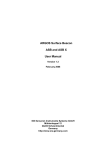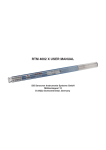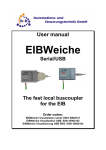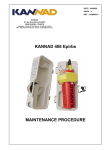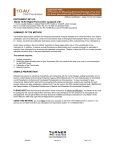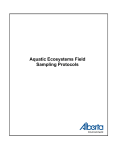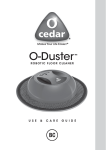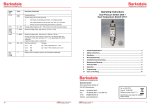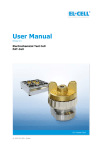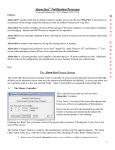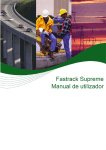Download SMM 500 - SiS - Sensoren Instrumente Systeme GmbH
Transcript
Subsurface Mooring Monitoring Beacons SMM 500 and SMM 500X User Manual Version 1.3 February 2008 SiS Sensoren Instrumente Systeme GmbH Mühlenkoppel 12 24222 Schwentinental Germany http://www.sis-germany.com Contents 1. General Information ..............................................................................................2 1.1 Description ........................................................................................................2 1.2 Switch Mode Power Supply Option.................................................................2 2. Operating Instructions ..........................................................................................3 2.1 Choosing Batteries for your Application ........................................................3 2.2 Opening the Housing........................................................................................3 2.3 Insertion of Batteries ........................................................................................3 2.4 Replacement of Moisture Absorbent ..............................................................3 3. Principle of Operation ...........................................................................................4 3.1 SMM Operation..................................................................................................4 3.2 CLS Argos Localisation Service......................................................................4 3.3 Admission to the Argos System......................................................................4 4. Maintenance...........................................................................................................4 4.1 Maintenance Notes ...........................................................................................4 4.2 Maintenance Parts and Tools ..........................................................................4 4.3 General Disassembly........................................................................................5 4.4 Replacement of Main Housing O-rings ...........................................................5 4.5 Replacement of Pressure Switch ....................................................................5 4.6 General Assembly.............................................................................................6 5. Appendix ................................................................................................................6 5.1 Technical Specification ....................................................................................6 5.2 Warranty and Support ......................................................................................7 List of Figures Figure 1 SMM 500 ......................................................................................................2 Figure 2 Membrane....................................................................................................5 1 1. General Information 1.1 Description The SMM 500(X) consists of a titanium tube closed by end caps made of Delrin. The bigger upper cap contains the antenna. 60,3 +0.7 853,0 198,0 +/-1.0 81,0 +/-1.0 574,0 +/-1.0 Titanium tube Delrin antenna dome with internal antenna Delrin cap with pressure switch Scale Date Clrk Chkd Norm Name 12.10.93 Ar Sensoren Instrumente Systeme GmbH Rev Modification Date Name SMM 500 Sheet of 1 1 Figure 1 SMM 500 Inside the housing is a battery holder for one bundle of 5 batteries in series. The batteries power the transmitter (PTT) directly or via an optional switch mode power supply (X Option). The power is switched on by a pressure switch inside the lower cap. The switch is separated by a membrane from seawater. The pressure transmission is done by silicon oil. The SMM 500X is for shallow water moorings up to 500 m. If you need a SMM for deep sea moorings please use the SMM 2000 (X) or SMM 6000 (X) series. 1.2 Switch Mode Power Supply Option Instruments marked with an X have the extended battery option. They can be used with a wider selection of battery types. The battery voltage is converted to the right level by a switch mode power converter. For instruments without the X-option, the batteries directly power the transmitter. The X-option may be installed to all systems later. 2 2. Operating Instructions 2.1 Choosing Batteries for your Application The cell voltage has to be between 2.2 V and 5.2 V. For instruments with the X-option the cell voltage has to be between 0.8 V and 5.2 V allowing the usage of alkaline batteries or nickel cadmium accumulators as well. For long term moorings in cold environment we recommend to use high quality Lithium cells. The batteries must be able to source 350 mA continuous current and 1700 mA pulse current. So you should use a battery type which has good efficiency with high currents. This applies especially to Lithium and Lithium Thionyl Chloride Batteries. For calculation of battery lifetime use the average power consumption when surfaced. Divide the energy content of the 5 batteries by the mean power consumption (100 mW) of the beacon. The table shows typical life times for different battery types: Temperature 20 °C 0 °C -30 °C Lithium battery: Alkaline battery: NC battery: Lithium 75 days 75 days 70 days Alkaline 30 days 25 days not applicable NC 15 days 14 days not applicable Silberkraft Eternacell, Lithium-SO2, Size D, Capacity 10 Ah Philips LR20, Green Alkaline, Size D, Capacity 13.2 Ah Panasonic 4000N, NC, Size D, Capacity 4 Ah For instruments without the X option use the Lithium values only! 2.2 Opening the Housing You open the housing by removing the end caps. The caps are fastened with the tube by threads. For opening please screw the lower cap anti-clockwise thereby turning the cap out of the tube. The inner part is fastened at the upper cap. Normally you don't have to remove the instrument from the housing. 2.3 Insertion of Batteries Don't open the housing by removing the upper cap. Open the housing by removing the lower cap. You will now find a PVC disc, take it out and you will see a tube in a PVC block. Put 5 pieces D type batteries into the tube oriented with the plus terminal in direction of the antenna cap. If you want the instrument to operate after insertion of batteries, close the housing by screwing in the lower cap clockwise. In case you only want to insert batteries but later on want to operate, please place the PVC disk for isolation between batteries and cap. 2.4 Replacement of Moisture Absorbent The printed circuit boards are protected by coating, but condensation of humidity should be avoided. When leaving the factory, the instrument is filled with dry argon gas and four small packs with moisture absorbent are placed in slots between the battery holder and the titanium housing at the lower end. We recommend filling with dry gas or replacing the moisture absorbent after every opening of the housing. Normally together with battery 3 replacement. With the instrument we deliver some packs with moisture absorbent sealed in a plastic bag. 3. Principle of Operation 3.1 SMM Operation The SMM 500 subsurface mooring monitoring beacons go down with the mooring up to 500 m with the PTT cut off by the pressure switch. If the mooring line should break, or when the mooring is being recovered, the PTT will switch on as it approaches the surface. In the first case, the beacon will transmit for the lifetime of the batteries (typically 3 months) in the second, the beacon is manually switched off after recovery. 3.2 CLS Argos Localisation Service CLS Service Argos has developed a special service for monitoring the status of the moorings. An alarm state is set upon reception of the signal by an orbiting satellite and recognition and processing at a ground centre. A warning that the mooring has surfaced, with its position, will be sent to the user by email, fax or telex. Thereafter each satellite pass will result in another location and another alarm message until a specified maximum number of messages has been sent. Generation of alarm messages may be cancelled by the user at any time. Users always may access data on-line (e.g. via Telnet). 3.3 Admission to the Argos System The user must fill out some forms and forward it to the Argos User Office: • Argos System Use Agreement • Service Contract/Order Form Please see the Argos documentation for detailed information. 4. Maintenance 4.1 Maintenance Notes The replacement of the wearing parts, described below, should only be done by qualified technical personnel. Inexpert handling can produce serious damage. 4.2 Maintenance Parts and Tools Requires (depends on the parts to be replaced): • SMM 500 pressure switch spare part kit with: 1 x SMM 500 pressure switch (adjusted to 3 - 5 m) 1 x O-ring, 15.6 x 1.78, 90 shore 1 x O-ring, 4.47 x 1.78, 90 shore 1 x silicon oil (AK 100, Wacker Chemie, FRG) 1 x membrane (60EPDM/266, Carl Freudenberg, Reichelsheim, FRG) 4 x slotted countersunk head screw, DIN 963, M3x8, titanium • SMM 500 housing O-rings 4 x O-ring, 52.07 x 2.62, 90 shore • silicon paste (e.g. TEGO-Silikonpaste S 200, Th. Goldschmidt AG, Essen, FRG) or silicon-based O-ring lubrication (e.g. Super-O-Lube, Parker) • cleaning cloth (not napped) • screw driver for M3 screws (for pressure switch plate) • screw driver for M4 screws (for pressure switch connection) • small screw driver 4 • thin tape • 24 mm tubular socket wrench (for pressure switch) 4.3 General Disassembly • Remove the pressure switch housing. • Remove the antenna dome housing. 4.4 Replacement of Main Housing O-rings • Remove the O-rings from the housings with the small screw driver. Be carefully to make no marks in the grooves. • Clean the O-ring grooves with the dry cleaning cloth. • Check the grooves for marks. If there are any marks, replacement of the antenna dome or pressure switch housing is necessary. • Cover up the ring followers at the housings with the tape. • Check the new O-rings for damage. • Grease the O-rings very slightly with the silicon paste. There should only be a thin film on the rings. • Put a piece of paper around the battery tube and slide two O-rings over the paper. • Push the paper with the O-rings over the battery tube and the ring follower and fit the Orings in the grooves of the antenna dome. • Fit the other two O-rings in the grooves of the pressure switch housing. • Remove the tape from the ring followers. 4.5 Replacement of Pressure Switch • • • • • • • • • • • • • • • • • Unscrew the slotted countersunk head screw from the ring follower. Unscrew the ring follower (right-handed thread). Detach the cables from the pressure switch. Turn around the housing and unscrew the four countersunk head screws at the plate. Remove the plate and the old membrane and pour out the oil. Turn around the housing and loosen the pressure switch with the tubular socket wrench (right-handed thread). Remove the old O-rings from the pressure switch. Clean the grooves. Slightly grease the new O-rings and fit them in the grooves of the pressure switch. Refit the pressure switch or replace by a new one (don't screw too tight). Turn around the housing and fill the hole nearly up to the border with new oil from the spare parts kit. Prepare the new membrane according to Figure 2 and insert the membrane. Refit the plate and screw it with the four new screws from the spare parts kit. Fasten the cables at the pressure switch and turn the ring follower until the cables are untwisted. Turn the ring follower three turns to the left, insert and fasten it (approx. 6 turns right, not too tight). Turn the ring follower until the screw hole is in alignment with the thread in the housing. Insert and fasten the slotted countersunk head screw. If the screw turns sluggish, turn the ring follower a little bit. Figure 2 Membrane 5 4.6 General Assembly • Reassemble the pressure switch housing at the end with the battery sign and the antenna dome housing at the other side. 5. Appendix 5.1 Technical Specification Mooring depth Pressure switch threshold Dimensions (l x d) Mass without batteries Displacement Power Supply Battery Types without option X Battery Types with option X 500 m 3-5m 853 x 60.3 mm 3.8 kg 2.4 dm3 5 pcs. D cells Lithium or Lithium Thionyl Chloride (1) NC, Alkaline, Lithium or Lithium Thionyl Chloride (1) 2.2 V - 5.2 V 0.8 V - 5.2 V 1700 mA 100 mW up to 2 years up to 6 months 3 months Serpe IESM Elta / CEIS PTT 07 UHF 88 or HAL2 33 dBm (2 W) 33 dBm (2 W) 32 bits 32 bits 90 seconds 90 seconds 410.650 MHz 410.650 MHz (UHF88) 410.620 MHz 410.630 MHz (HAL2) Battery cell voltage (without option X) Battery cell voltage (with option X) Peak supply current Average power consumption when surfaced Mooring life Mooring life in euphotic zone Transmission life with Lithium cells Transmitter manufacturer (2) Transmitter model (2) Output power Message Length (3) Repetition rate (4) Transmit frequency (5) Notes: 1. The used batteries must be able to source 350 mA continuous current and 1700 mA pulse current. Some low current types of Lithium Thionyl Chloride batteries can’t be used. 2. There are three transmitter models used with the SMM. Instruments manufactured from 2003 to 2006 are equipped with the Serpe IESM PTT 07 model, those made since 2006 are equipped with the Elta HAL2 model while older instruments use the Elta / CEIS UHF 88 model. 3. The SMM did not send any user data. Therefore, the message length is set to the minimum value of 32 bits. With Elta HAL2 transmitters, a prefix byte (typ. 25 hex, with 20-bit ID only), temperature (°C), supply voltage (mV / 64) and power indication (mV / 4) are send. 4. The default repetition rate is 90 seconds (recommended by Argos). Other rates (e.g. 60 seconds) can be programmed upon request. 5. With Elta HAL2 transmitters, the transmit frequency is programmed to 401.630 MHz according to the Argos recommendations. With UHF 88 transmitters, the frequency is fixed at 401.650 MHz. The transmit frequency of PTT 07 is set by the manufacturer. 6 5.2 Warranty and Support SiS warrants this instrument to the original purchaser to be free of defects in material or manufacturing for a period of two years. Liability is limited to repair or replacement of the defective part which will be done without charge if the instrument is returned to our factory prepaid. This warranty does not apply to instruments subjected to misuse or tampering. No responsibility or warranty for consequential damage is included in the sale of this instrument. SiS - Sensoren Instrumente Systeme GmbH Mühlenkoppel 12, D-24222 Schwentinental, Germany Tel.: +49-431-79972-0 Fax: +49-431-79972-11 Email: [email protected] WWW: http://www.sis-germany.com 7









